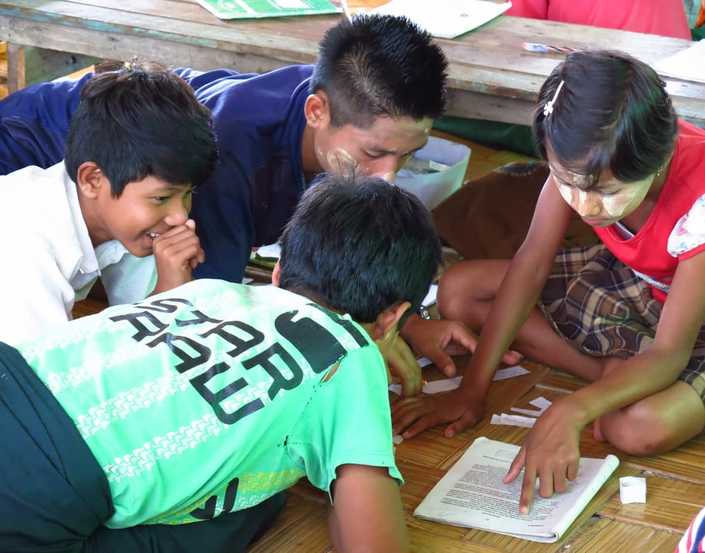|
The topic was Fleming and his discovery of penicillin. Our teacher trainee brought colored board markers and made characters of anti-bodies, penicillin, red and white blood cells. The students were split into groups to role-play the anti-bodies fighting infection and then penicillin swooping in to save the day. The short amateur dramatics were grading on clarity of English and overall enthusiasm with a three question quick-fire rapid answer tie-break. Van and I were the judges of the village am dram, with no clear winner emerging. We were confused as to why very few of the students seemed to be getting into character. They were very timid and didn’t seem to have fully grasped what was expected of them, despite the example and precise instructions.
After the engaging role-play, the students read from flip chart paper with a short version of the printed reading story in the government textbook in the same groups. We soon saw group leaders emerging and realized that some students were less than engaged. It was time to try a new method of grouping. While there is research that suggests pupils work well in constant groupings, I feel that this is only necessary in large group situations where introverted pupils feel safer in a known group. With 20 students I didn’t see the need for the ongoing sameness. Also, upon seeing some students emerge as group leaders and others become disengaged, I decided that we should try grouping by level. That way, we could set each level a different task related to the overall theme, which would hopefully stimulate everyone to the right level, while not boring anyone or leaving people confused about the stimulus. Going into class the next day, we felt a ripple of excitement; maybe now with differentiation, we would see more engaged students for more of the available teaching time. Hopefully the slight differences in levels would jolt the students into seeking and retaining information where before they may have felt only discouragement that they were never going to be that good, or conversely that they had been stuck with a lower level student. In addition to the change in groups, we had also revised the short versions of the text that the students were given to read and work with according to level of difficulty. In this way, we hoped that all of the students could appreciate the text and its meaning without being overwhelmed or underworked. Chloe Smith NEH Director of Studies and Teacher Trainer Related Posts: Collaborating as a Group Students Adapt to Active Learning Giving and Receiving Honest Feedback Guest Article | Engaging Young Learners in Rural Myanmar Motivating Young Rural Students
Comments
|
This section will not be visible in live published website. Below are your current settings: Current Number Of Columns are = 3 Expand Posts Area = 1 Gap/Space Between Posts = 20px Blog Post Style = card Use of custom card colors instead of default colors = Blog Post Card Background Color = current color Blog Post Card Shadow Color = current color Blog Post Card Border Color = current color Publish the website and visit your blog page to see the results |
|
© New Education Highway 2024
Except where otherwise noted, content on this site is licensed under a Creative Commons Attribution 4.0 International License. |


